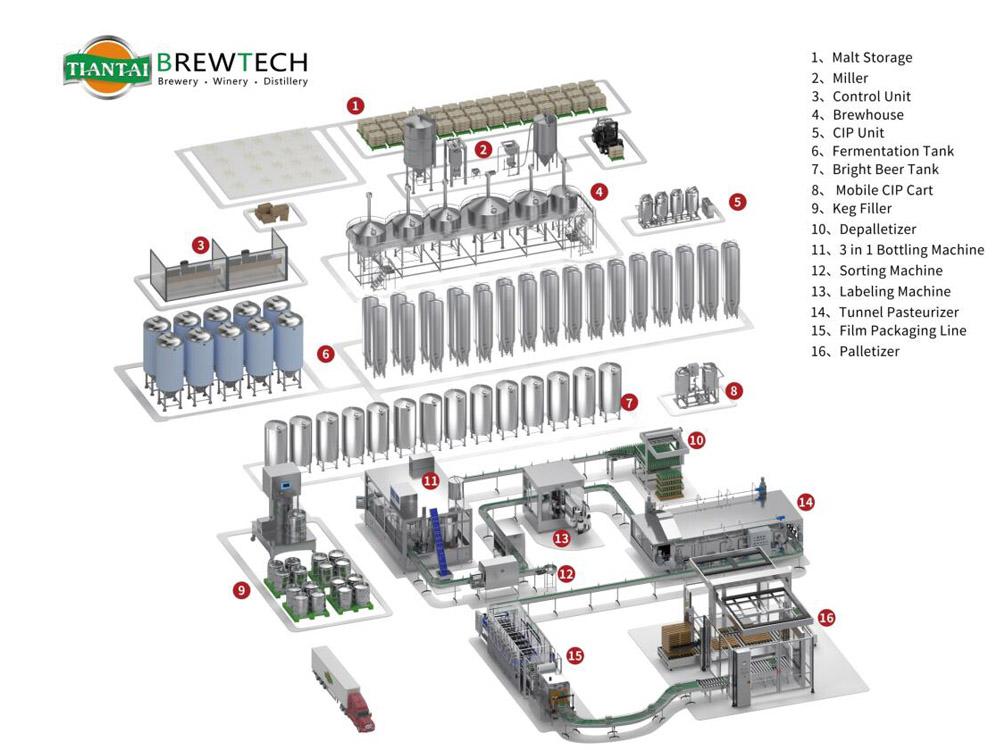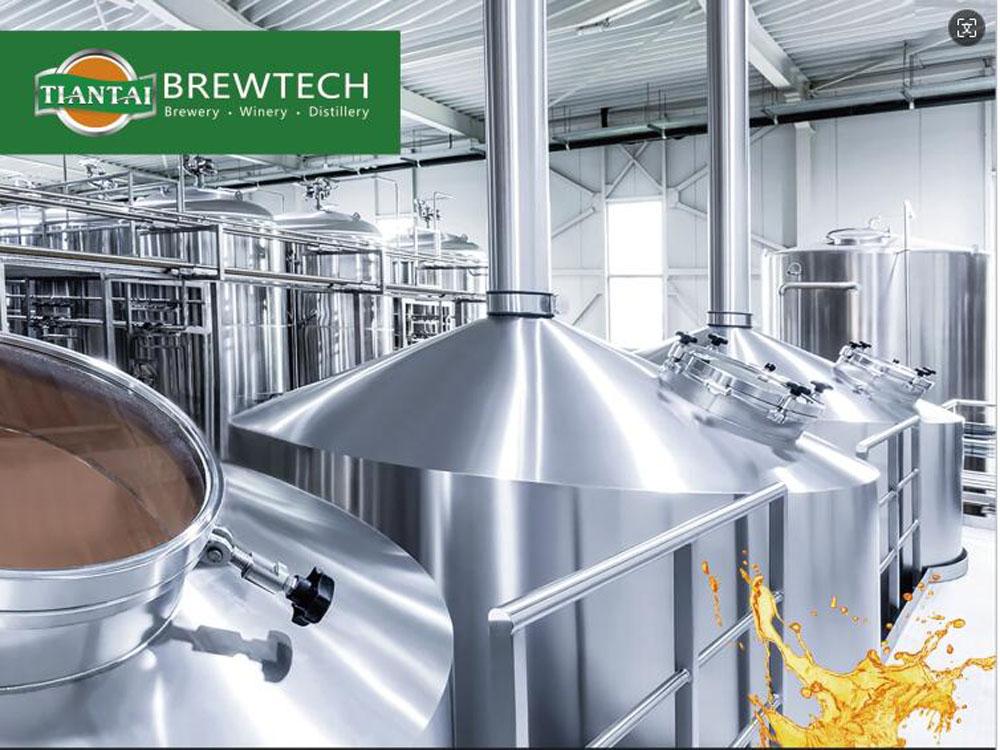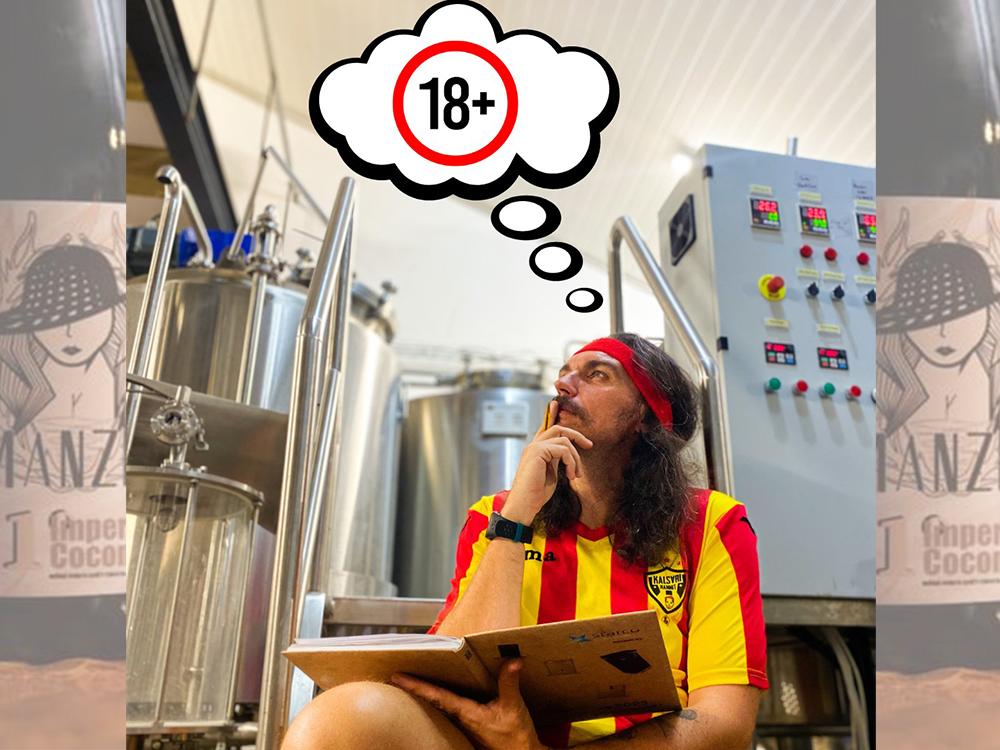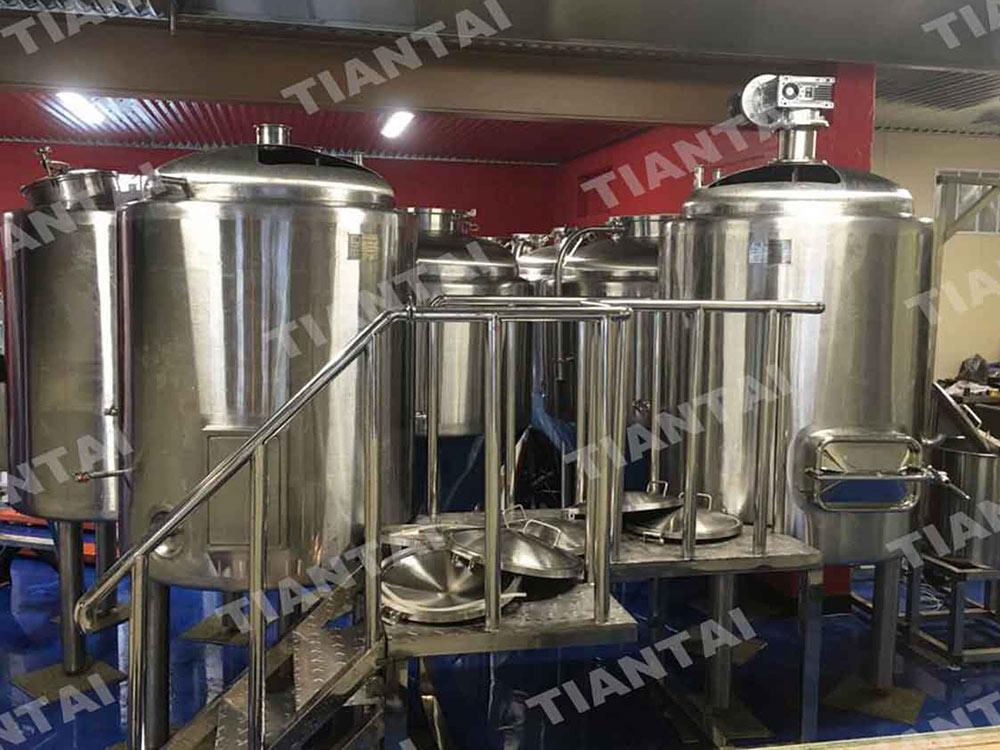10,000KL Annual Production Brewery
- Sep 29, 2026
- 157
- tiantai
1.) Brief introduction
Scale Brewery equipment is dedicated to the production of beer for mass distribution and sale, typically ranging from 10,000KL to 100,000KL annual production. Unlike microbreweries or craft breweries, scale brewery usually utilizes advanced brewing equipment, full-automated systems and standardized processes to maintain consistent quality and efficiency, and the beer is distributed regionally, nationally, or even internationally.

2.) Design Basis of 10,000KL Annual Production Brewery
3.) Key Equipment of 10,000KL Annual Production Brewery

4.) Brewing technology of 10,000KL Annual Production Brewery
Ingredients Crushing and Feeding: Equipped with bucket elevator,Scraper conveyer, grist silo and mill etc, with precise malt dosing controlled by load cells.Each batch takes about 20 minutes for crushing.
Mashing: Utilizing an immersion mashing process with over 10 pre-stored recipes. The mashing process is fully automated.
Lautering: The spent grain bed is designed to be 30-40 cm thick, and spent grain is conveyed via gas pulse system. A storage tank supports two days' worth of production.
Boiling: Atmospheric boiling with internal heaters to enhance boiling strength. Evaporation intensity is 8%. It includes an automatic 200L hop dosing tank, with heat recovery from the chimney using a tube heat exchanger.
Whirlpool: Whirlpool inlet at 1/3 of the tank height, with a sloped bottom to reduce beer loss. Hot break is flushed from the center of the bottom.
Cooling: One-stage cooling with 2°C chilled water, reducing energy and water consumption. The process generates 80°C hot water, which is recovered and stored in a hot water tank.
Oxygenation: Sterile oxygenation with compressed air and terminal filters (0.01um), achieving oxygen levels of 8mg/L.
Yeast Addition: Liquid yeast from yeast propagation is added to the wort post-cooling as it flows through the wort line into the fermentation tank.
Fermentation: Single-tank fermentation process with a 20-day fermentation cycle. Hygienic pipe plates ensure there are no dead corners for cleaning. Two tanks are grouped with closed pipelines, preventing contamination.
Yeast Recovery: Yeast is manually recovered into 600L and 1500L recovery tanks.
Yeast Propagation: Using a three-stage yeast propagation technique.
Dry Hopping: Special equipment for dry hopping is provided, considering the large hop additions required for 13-15P IPA.
Filling: Beer from the fermentation vessels (FV) is transferred to bright beer tanks (BBT) for constant pressure filling. Beer kegs can be filled directly from the FV.
Dissolved Oxygen: Less than 40PPB, with air content below 1ml.
Production Time: Each batch takes approximately 7 hours to produce.
Spent Grain Handling: Spent grain is conveyed using a gas pulse system, with storage tanks that can support all-day production. The mashing system's capacity allows for 8 batches per day. The system is equipped with Siemens S7-1500 CPU modules, enabling full automation in the brewing process. Sensors and low-voltage electrical components are from leading international brands.
Production Safety: Safety features include proximity switches on manholes, boiling foam electrodes to prevent overflow, stainless steel piping, automatic CIP dosing system, hygienic pipe plates, and contamination prevention.
Energy Efficiency: Steam line condensate recovery, boiling heat recovery, hot water recovery after heat exchangers, CO2 recovery, electricity savings through nighttime cooling, yeast recovery and sales, and spent grain recovery and sales.

5.) Features of 10,000KL Annual Production Brewery
1. High Capacity
Multiple brewhouses that allow for simultaneous brewing processes, speeding up production.
2. Automated Processes
Full-Automated control systems with PLC and Industrial Computer to control temperature, flow rates, and pressure etc, reducing human intervention.
3. Energy Efficiency
Heat Recovery Systems: Use of steam or water in heat exchangers to recover energy during brewing, reducing energy costs.
Efficient Cooling: Advanced glycol or ammonia-based cooling systems to efficiently regulate temperatures in fermenters and brite tanks.
4. Durability and Material
Stainless Steel Construction: 304 or 316-grade stainless steel for corrosion resistance and longevity, especially in contact with acidic environments.
Robust Design: Designed to withstand constant heavy use and cleaning procedures.
5. Hygiene and Cleaning Systems
CIP (Clean-In-Place) Systems: Automatic cleaning systems that use a combination of cleaning agents and water to clean the interior surfaces of tanks, pipes, and fittings without disassembly.
Sanitary Piping and Valves: Use of sanitary design features to prevent contamination and ensure smooth cleaning operations.
6. Modular and Scalable Design
Expandable Systems: Equipment designed for expansion, allowing the brewery to scale production as demand increases.
Modular Components: Systems that can be upgraded or reconfigured without disrupting production.
7. Precision in Process Control
Accurate Measurement Sensors: Sensors for temperature, pH, flow rate, and pressure that provide precise control of the brewing parameters.
Recipe Management: Software to store and replicate beer recipes, ensuring consistency across batches.
8. Integrated Packaging
Automated Bottling, Canning Lines and Canning Lines: High-speed machines for bottling, canning, and kegging beer with minimal human intervention.
Labeling and Packaging Automation: Machines that apply labels, package bottles/cans, and prepare the beer for distribution.
9. Waste Management
Effluent Treatment Systems: Treatment of waste water and byproducts to meet environmental regulations.
Spent Grain Handling: Systems to efficiently manage and dispose of or repurpose spent grains.
10. Customizable Configurations
Bespoke Designs: Tailored equipment configurations to meet the specific needs of the brewery, depending on size, production goals, and beer types.
These features enable scale breweries to maintain high efficiency, consistency, and cost-effectiveness while meeting the demand for mass beer production.


Tiantai Brewtech supplies one-stop service for turnkey scale brewery project. We have helped 2600+ customers to build their brewery in 96+ countries. Feel free to talk with us to discover latest brewery solutions together.
Scale Brewery equipment is dedicated to the production of beer for mass distribution and sale, typically ranging from 10,000KL to 100,000KL annual production. Unlike microbreweries or craft breweries, scale brewery usually utilizes advanced brewing equipment, full-automated systems and standardized processes to maintain consistent quality and efficiency, and the beer is distributed regionally, nationally, or even internationally.

2.) Design Basis of 10,000KL Annual Production Brewery
|
Annual Production
|
10,000KL |
| No. Of Working Days Per Year | 300 Days |
| No. Of Brews Per Day | 6-8 Brews |
| Fermentation Cycle | 20 Days |
| Ingredients | Barley Malt with rice and corn |
| Total Losses | 10% including 4% contraction losses |
| Packaging | 60% Bottles, 30% Cans and 10% Kegs |
| Minimum/Maximum Ambient Temperature | -10℃-45℃ |
| Electrical Power Supply | 3Phase, 220-415V, 50/60Hz |
3.) Key Equipment of 10,000KL Annual Production Brewery
| Malt Milling Unit | Bucket Elevator |
| Malt Storage Tank | |
| Scraper conveyer | |
| Dry Miller/Wet Miller | |
| Grist Silo | |
| Milling Controlling Cabinet | |
| Brewhouse Unit | 5KL Mash Tun |
| 3KL Cooker | |
| 5KL Lauter Tun | |
| 5KL Kettle Tun | |
| 5KL Buffer Tun | |
| 5KL Whirlpool Tun | |
| With Pump, Valves, Pipe, Heat Exchanger etc | |
| Cellar Unit | 4x 10KL Fermenter |
| 4x 10KL Fermenter | |
| 16x 30KL Fermenter | |
| Filtration Unit | Filtration Unit |
| Bright Beer Tank | 1x 20KL Bright Beer Tank |
| 1x 30KL Bright Beer Tank | |
| Packaging Unit | 4000bph Bottling Line |
| 2000cph Canning Line | |
| 30-40kph Kegging Line | |
| CIP Unit |
1000L Brewhouse CIP System, Caustic Tank + Hot Water Tank |
| 3000L Cellar CIP System, Hot Water Tank+Acid Tank +Caustic Tank+Sterilize Tank | |
| Control Unit | Full-Automatic PLC with Industrial Computer |
| Utility System |
Water Treatment System, Steam Generating System, Air Compressor, Glycol Chilling System etc |

4.) Brewing technology of 10,000KL Annual Production Brewery
Ingredients Crushing and Feeding: Equipped with bucket elevator,Scraper conveyer, grist silo and mill etc, with precise malt dosing controlled by load cells.Each batch takes about 20 minutes for crushing.
Mashing: Utilizing an immersion mashing process with over 10 pre-stored recipes. The mashing process is fully automated.
Lautering: The spent grain bed is designed to be 30-40 cm thick, and spent grain is conveyed via gas pulse system. A storage tank supports two days' worth of production.
Boiling: Atmospheric boiling with internal heaters to enhance boiling strength. Evaporation intensity is 8%. It includes an automatic 200L hop dosing tank, with heat recovery from the chimney using a tube heat exchanger.
Whirlpool: Whirlpool inlet at 1/3 of the tank height, with a sloped bottom to reduce beer loss. Hot break is flushed from the center of the bottom.
Cooling: One-stage cooling with 2°C chilled water, reducing energy and water consumption. The process generates 80°C hot water, which is recovered and stored in a hot water tank.
Oxygenation: Sterile oxygenation with compressed air and terminal filters (0.01um), achieving oxygen levels of 8mg/L.
Yeast Addition: Liquid yeast from yeast propagation is added to the wort post-cooling as it flows through the wort line into the fermentation tank.
Fermentation: Single-tank fermentation process with a 20-day fermentation cycle. Hygienic pipe plates ensure there are no dead corners for cleaning. Two tanks are grouped with closed pipelines, preventing contamination.
Yeast Recovery: Yeast is manually recovered into 600L and 1500L recovery tanks.
Yeast Propagation: Using a three-stage yeast propagation technique.
Dry Hopping: Special equipment for dry hopping is provided, considering the large hop additions required for 13-15P IPA.
Filling: Beer from the fermentation vessels (FV) is transferred to bright beer tanks (BBT) for constant pressure filling. Beer kegs can be filled directly from the FV.
Dissolved Oxygen: Less than 40PPB, with air content below 1ml.
Production Time: Each batch takes approximately 7 hours to produce.
Spent Grain Handling: Spent grain is conveyed using a gas pulse system, with storage tanks that can support all-day production. The mashing system's capacity allows for 8 batches per day. The system is equipped with Siemens S7-1500 CPU modules, enabling full automation in the brewing process. Sensors and low-voltage electrical components are from leading international brands.
Production Safety: Safety features include proximity switches on manholes, boiling foam electrodes to prevent overflow, stainless steel piping, automatic CIP dosing system, hygienic pipe plates, and contamination prevention.
Energy Efficiency: Steam line condensate recovery, boiling heat recovery, hot water recovery after heat exchangers, CO2 recovery, electricity savings through nighttime cooling, yeast recovery and sales, and spent grain recovery and sales.

5.) Features of 10,000KL Annual Production Brewery
1. High Capacity
Multiple brewhouses that allow for simultaneous brewing processes, speeding up production.
2. Automated Processes
Full-Automated control systems with PLC and Industrial Computer to control temperature, flow rates, and pressure etc, reducing human intervention.
3. Energy Efficiency
Heat Recovery Systems: Use of steam or water in heat exchangers to recover energy during brewing, reducing energy costs.
Efficient Cooling: Advanced glycol or ammonia-based cooling systems to efficiently regulate temperatures in fermenters and brite tanks.
4. Durability and Material
Stainless Steel Construction: 304 or 316-grade stainless steel for corrosion resistance and longevity, especially in contact with acidic environments.
Robust Design: Designed to withstand constant heavy use and cleaning procedures.
5. Hygiene and Cleaning Systems
CIP (Clean-In-Place) Systems: Automatic cleaning systems that use a combination of cleaning agents and water to clean the interior surfaces of tanks, pipes, and fittings without disassembly.
Sanitary Piping and Valves: Use of sanitary design features to prevent contamination and ensure smooth cleaning operations.
6. Modular and Scalable Design
Expandable Systems: Equipment designed for expansion, allowing the brewery to scale production as demand increases.
Modular Components: Systems that can be upgraded or reconfigured without disrupting production.
7. Precision in Process Control
Accurate Measurement Sensors: Sensors for temperature, pH, flow rate, and pressure that provide precise control of the brewing parameters.
Recipe Management: Software to store and replicate beer recipes, ensuring consistency across batches.
8. Integrated Packaging
Automated Bottling, Canning Lines and Canning Lines: High-speed machines for bottling, canning, and kegging beer with minimal human intervention.
Labeling and Packaging Automation: Machines that apply labels, package bottles/cans, and prepare the beer for distribution.
9. Waste Management
Effluent Treatment Systems: Treatment of waste water and byproducts to meet environmental regulations.
Spent Grain Handling: Systems to efficiently manage and dispose of or repurpose spent grains.
10. Customizable Configurations
Bespoke Designs: Tailored equipment configurations to meet the specific needs of the brewery, depending on size, production goals, and beer types.
These features enable scale breweries to maintain high efficiency, consistency, and cost-effectiveness while meeting the demand for mass beer production.


Tiantai Brewtech supplies one-stop service for turnkey scale brewery project. We have helped 2600+ customers to build their brewery in 96+ countries. Feel free to talk with us to discover latest brewery solutions together.


.jpg)

